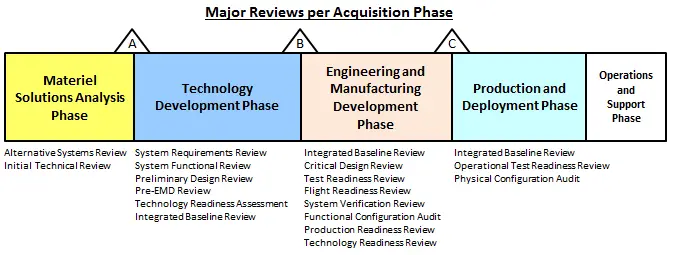The System Functional Review (SFR) is a technical review to ensure that the system’s functional baseline is established and can satisfy the requirements of the Initial Capabilities Document (ICD) or draft Capability Development Document (CDD) within the currently allocated budget and schedule. It also determines whether the system’s lower-level performance requirements are fully defined and consistent with the system concept and whether lower-level systems requirements trace to top-level system performance requirements.
Definition: The System Functional Review (SFR) is a p[rogram lead review that assesses if the functional baseline meets the needs and requirements of the end-user and if the functional requirements and testing methods help meet the performance requirements.
System Functional Review (SFR) Purpose
The purpose of the SFR is to determine if the system’s functional definition is fully decomposed to its lower level and that Integrated Product Teams (IPT) are prepared to start preliminary design.
What is the Functional Baseline
The functional baseline describes the system’s performance (its functional, interoperability, and interface characteristics), as well as the testing that needs to be done to show that these characteristics have been met. The operational standards in the Initial Capabilities Document (ICD) and draft Capability Development Document (CDD) can be traced back to the functional baseline.
When is a System Functional Review (SFR) Conducted
The SFR is conducted during the Technology Maturation and Risk Reduction (TMRR) Phase of a program.
System Functional Review (SFR) Evaluation
A critical component of an SFR review is the development of representative operational use cases for the system. System performance and the anticipated functional requirements for operations maintenance and sustainment are assigned to sub-systems, hardware, software, or support after a detailed analysis of the architecture and the environment in which it will be employed.
The system’s lower-level performance requirements are evaluated to determine whether they are fully defined and consistent with the system concept and whether traceability of lower-level systems requirements to top-level system performance and the CDD is maintained. This activity results in two major systems engineering products: the final version of the system performance specification and the draft version of the performance specifications, which describe the items below the system level (item performance specifications).
System Functional Review (SFR) Results
Completion of the SFR should provide the following:
- An established system functional baseline with traceability to lower-level performance requirements,
- An updated risk assessment for the Engineering, Manufacturing, and Development (EMD) Phase,
- An updated Cost Analysis Requirements Description (CARD) or a CARD-like document based on the system functional baseline,
- An updated program development schedule including system and software critical path drivers, and
- A preliminary system-level maintenance plan with updates applicable to this phase.
AcqTips:
- The SFR is the first review that begins to allocate requirements to separated sub-systems and organizational IPTs
- An SFR review is where the need for Interface Control Documents becomes necessary to define areas of responsibility and constraints requiring coordination across IPTs.
AcqLinks and References:
- Defense Acquisition Guidebook (DAG) – Chapter 3
- System Functional Review Checklist – 2010
- SFR Exit Criteria Questions
Updated: 5/12/2023
Rank: G1.2

